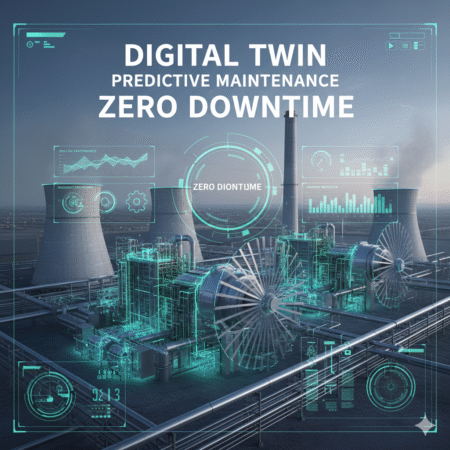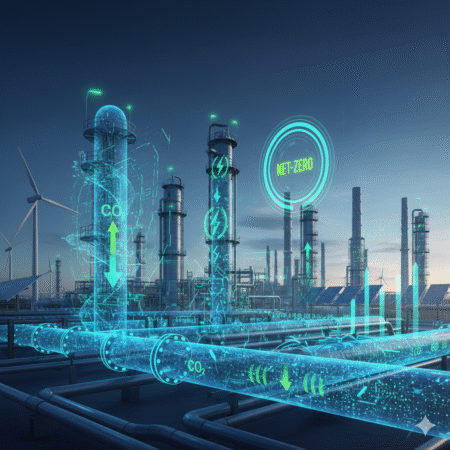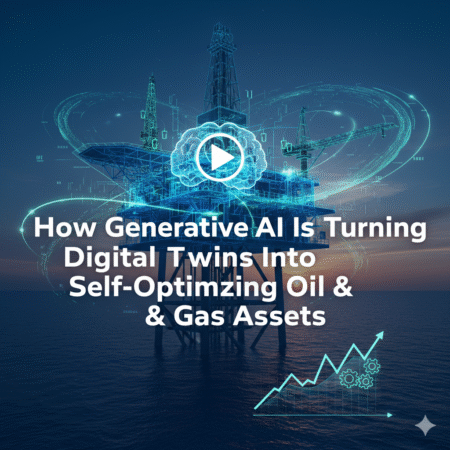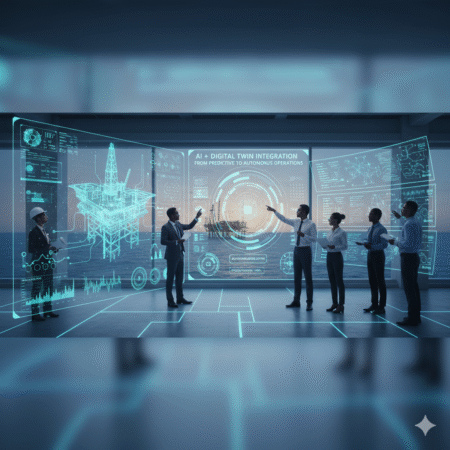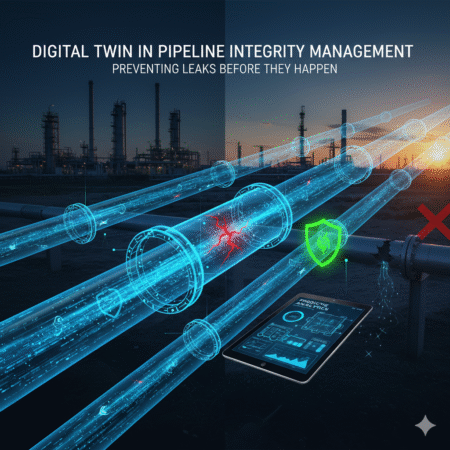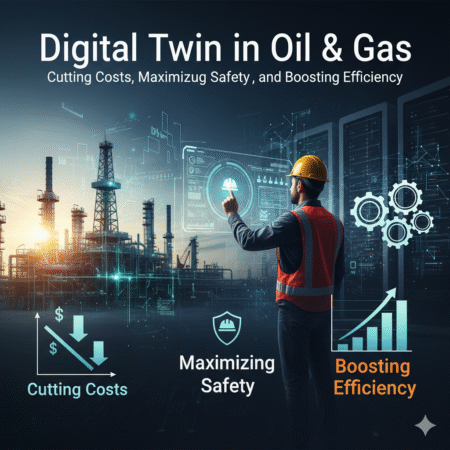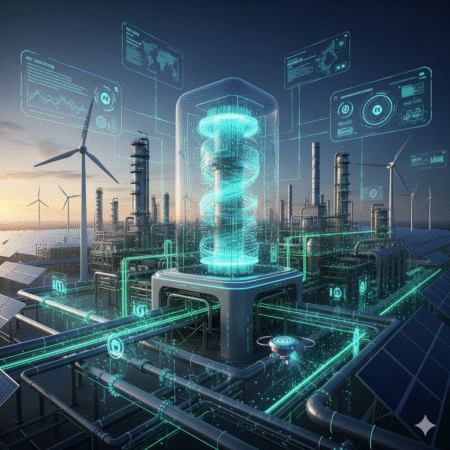
- Introduction: Why Zero Downtime Matters in Power Plants
- What is a Digital Twin in Power Plants?
- Predictive Maintenance: The Core Promise
- Key Benefits for Operators & Grid Stability
- Use Cases & Real-World Examples
- Challenges & Barriers to Adoption
- Future Outlook: Toward Autonomous Power Plants
- Conclusion + FAQ + CTA
Introduction: Why Zero Downtime Matters in Power Plants
Imagine this: it’s the middle of summer in Texas, temperatures soar past 105°F, and every household has their air conditioning on full blast. Suddenly, a power plant trips offline. Within minutes, the grid becomes unstable, blackouts ripple across cities, and losses begin to mount. For utilities, this isn’t just a technical hiccup-it’s a million-dollar problem per hour.
In fact, industry reports show that unplanned downtime in power generation can cost between $500,000 to $1,000,000 per hour, depending on the plant’s size and the grid’s demand at the time. And here’s the kicker: 70% of these outages could have been prevented with better monitoring and predictive insights.
This is where digital twin technology comes in-not as a buzzword, but as a practical lifeline. Think of a digital twin as a living, breathing replica of your power plant, continuously fed by IoT sensors, SCADA data, and AI algorithms. Instead of waiting for a turbine to fail, or scrambling when a boiler tube bursts, operators can now “see the future” of their assets in real time.
Here’s a simple truth: in a world that’s pushing for higher reliability, stricter ESG compliance, and tighter profit margins, zero downtime isn’t a dream-it’s a business necessity.
But let’s pause for a second. Why has downtime become such a critical issue?
- Demand is peaking: global electricity demand is expected to rise by 25% by 2030, especially with EVs and electrification trends.
- Aging infrastructure: many coal, gas, and hydro plants in the US and Europe are 30–40 years old, making failures more likely.
- Renewable integration challenges: as wind and solar take larger shares of the grid, backup plants must stay ready at a moment’s notice.
The bottom line? Every minute of downtime weakens grid stability and drains millions in lost revenue.
This is why the industry is buzzing about digital twins. Unlike traditional maintenance, where operators either react after something breaks or perform costly preventive checks, digital twins predict failures before they happen. That means fewer outages, longer equipment lifespan, and ultimately, power plants that operate like clockwork.
Think of it as moving from firefighting to foresight. Instead of putting out emergencies, you’re avoiding them entirely.
And in the coming sections, we’ll break down exactly how digital twin technology is transforming power plants-from predictive maintenance and cost savings to real-world examples that prove it’s not just hype, but a competitive edge.
Maintenance Approaches in Power Plants
| Approach | How It Works | Impact on Downtime |
|---|---|---|
| Reactive | Fix after breakdown (run-to-failure). | High downtime, costly emergency repairs. |
| Preventive | Scheduled checks & part replacement (time-based). | Reduces risk, but can waste resources. |
| Predictive (with Digital Twin) | AI + sensor data forecast failures before they occur. | Near zero downtime, optimized maintenance cost. |
What is a Digital Twin in Power Plants?
Imagine this: a gas turbine in a power plant that costs tens of millions of dollars to install and maintain. Every vibration, every tiny fluctuation in temperature, every drop of efficiency matters. Now picture having a virtual replica of that turbine – one that mirrors its performance in real time, predicts issues before they happen, and lets you run “what-if” scenarios without touching the actual machine. That’s the power of a digital twin.
At its core, a digital twin is not just a 3D model. It’s a living, breathing digital version of physical assets like turbines, boilers, cooling towers, and transmission lines. This replica is continuously fed by data streams from IoT sensors, SCADA systems, and AI-powered analytics, creating a real-time mirror of plant operations.
Read More: Digital Twin and AI Synergy in Plant Operations
Why does this matter? Because power plants are complex ecosystems where a single failure – like a boiler tube leak – can cost millions in lost revenue and even lead to safety hazards. Digital twins allow operators to see problems before they become disasters. Instead of relying only on human inspection or scheduled maintenance, the twin acts like a 24/7 control tower for the plant.
Here’s a simple way to look at it:
| Traditional Monitoring | Digital Twin Monitoring | Impact |
|---|---|---|
| Manual checks every few weeks | Continuous real-time data flow | Early detection of hidden risks |
| Reactive fixes after failure | Predictive alerts before breakdown | Zero unplanned downtime |
| Limited visibility into system | Holistic plant-wide simulation | Smarter, faster decisions |
Companies like GE and Siemens Energy are already deploying digital twins in power generation. GE’s “Digital Twin for Gas Turbines” uses sensor data + AI algorithms to predict turbine blade fatigue months in advance, giving operators a head start to schedule maintenance without interrupting generation. Meanwhile, EDF in Europe is experimenting with hydro power twins to optimize water flow and prevent costly cavitation in turbines.
The bottom line? A digital twin is not a fancy dashboard. It’s a decision-making engine that transforms raw sensor data into actionable insights. For power plant operators, that means fewer surprises, higher reliability, and a big step toward the dream of zero downtime.
Predictive Maintenance: The Core Promise
Let’s be real: in a traditional power plant, maintenance often feels like a gamble. Either you wait until something breaks (reactive), or you schedule a time-based overhaul whether the equipment needs it or not (preventive). Both approaches are costly. Reactive means unplanned downtime that can run $1 million+ per hour. Preventive means spending money and man-hours replacing parts that may still have years of life left.
This is where predictive maintenance powered by digital twins flips the game.
Think of it this way: instead of guessing when a turbine blade will fail, the digital twin is constantly reading vibration patterns, temperature fluctuations, and pressure changes in real time. Using machine learning, it can say, “This blade has a 70% chance of cracking within 45 days if load continues at this rate.” That level of foresight is priceless.
Story time: A major gas-fired plant in Asia reported saving nearly $34 million annually after deploying a digital twin for its turbines. How? By catching micro-vibrations that human inspections never detected, they prevented catastrophic blade failures that would have taken the plant offline for weeks.
The evolution looks like this:
| Maintenance Type | Approach | Downside | Digital Twin Advantage |
|---|---|---|---|
| Reactive | Fix it after failure | High unplanned downtime costs | Predict failures before they occur |
| Preventive | Replace parts on schedule | Wasted resources, over-maintenance | Optimize asset life cycles |
| Predictive (Digital Twin) | Condition-based, data-driven | Requires IoT & AI investment | Zero downtime, maximum ROI |
Another classic case is boiler tube leaks. In coal or combined-cycle plants, even a small leak can cause cascading failures. Traditionally, operators would rely on periodic ultrasonic inspections. But with a digital twin, AI detects early thermal anomalies in the boiler walls, alerting operators weeks before the leak would’ve even been visible.
The result? Fewer forced outages, optimized spare parts inventory, and safer operations. In fact, a McKinsey report highlights that predictive maintenance can cut unplanned downtime by 30–50% and reduce maintenance costs by 10–40%.
And here’s the kicker: predictive maintenance is not just about saving money. It’s about protecting the grid. When one turbine goes down unexpectedly, it stresses the entire network, sometimes leading to blackouts. By keeping assets healthy and predictable, digital twins are essentially insurance policies for energy stability.
The promise of predictive maintenance is clear: zero downtime isn’t a dream anymore – it’s a strategy.
Key Benefits for Operators & Grid Stability
Here’s a question: What keeps power plant executives awake at night? It’s not just rising fuel costs or ESG audits – it’s the fear of unplanned downtime. Because when a turbine suddenly fails, it doesn’t just hit the balance sheet; it can take an entire city into darkness.
That’s why digital twin technology is being hailed as the ultimate game-changer for power plant operators. The benefits extend far beyond maintenance savings; they reach into grid reliability, regulatory compliance, and even the bottom line of investors.
Benefit #1: Reduced Downtime & Maintenance Costs
Every hour of unplanned outage in a power plant can cost $1–1.5 million. By simulating real-time conditions and predicting failures before they happen, digital twins cut downtime dramatically.
Example: A GE gas turbine plant in the U.S. reported a 15% reduction in OPEX after implementing digital twin–based predictive maintenance. That’s millions saved annually without compromising safety.
Benefit #2: Extended Equipment Lifespan
Instead of overhauling equipment on a fixed schedule, operators can squeeze more life out of turbines, boilers, and transformers by servicing only when needed. Digital twins reveal the true condition of each component.
A Siemens Energy study showed digital twin adoption extended turbine life cycles by 20–25%, delaying multi-million-dollar CAPEX replacements.
Benefit #3: Improved Efficiency → Lower Fuel Use & Emissions
A 1% improvement in thermal efficiency for a large power plant can save hundreds of thousands of tons of fuel annually. Digital twins optimize combustion patterns, monitor heat rates, and fine-tune performance in real time.
According to McKinsey, plants leveraging digital twins achieved 3–5% fuel savings, directly cutting CO₂ emissions – a win for both profit and ESG scores.
Benefit #4: Better Compliance with ESG & Regulatory Standards
Regulators are increasingly tough on emissions and reporting. Digital twins give operators a real-time dashboard of efficiency, safety, and sustainability metrics. Instead of scrambling for audits, plants can generate automated ESG reports backed by hard data.
EDF (Électricité de France) uses hydropower digital twins to optimize water flow and reduce ecological impact, aligning with EU decarbonization targets.
Quick Snapshot: The ROI of Digital Twins in Power Plants
| Benefit | Impact | Real-World ROI |
|---|---|---|
| Reduced Downtime | 30–50% fewer forced outages | $10M+ saved annually |
| Extended Asset Life | 20–25% longer lifespan | Deferred CAPEX by years |
| Efficiency Gains | 3–5% less fuel consumption | Lower OPEX + CO₂ cuts |
| ESG Compliance | Automated sustainability reports | Stronger investor trust |
The bottom line? Digital twins don’t just protect machines – they protect the entire energy ecosystem. Operators see leaner operations, regulators see cleaner performance, and investors see reduced risk. In other words: digital twins deliver profit, stability, and trust in one package.
Use Cases & Real-World Examples
Here’s the truth: digital twin adoption isn’t just theory anymore. Power plants worldwide are already putting this technology to work – from gas turbines in Texas to nuclear pilot projects in France. And the results? Millions in savings, improved uptime, and a stronger grid.
Think about it this way: ten years ago, operators were “flying blind,” relying on scheduled maintenance and gut feel. Today, with digital twins, they’re essentially running a live simulation of the plant 24/7, spotting issues before they snowball into blackouts.
Let’s break down how this looks in practice 👇
Gas Turbine Predictive Twin (GE & Siemens Energy)
Gas turbines are the backbone of power generation, but they’re also complex machines where even a small vibration anomaly can mean catastrophic failure.
- GE implemented a predictive digital twin on its 9HA gas turbine fleet. The result? A reduction of forced outages by 40%, translating into millions of dollars saved in downtime and repair costs.
- Siemens Energy used digital twins to monitor turbine blades in real time. By predicting thermal fatigue, plants extended blade life cycles by up to 25%, pushing expensive overhauls years down the line.
Hydropower Asset Monitoring (Voith & EDF)
Hydropower may seem low risk, but dams and turbines are exposed to massive mechanical stress and environmental conditions.
- Voith Hydro deployed digital twins on turbines across European hydropower plants. Operators reported a 20% efficiency improvement thanks to optimized water flow management.
- EDF, one of the largest utilities in Europe, is using hydropower twins not only for asset monitoring but also to reduce environmental impact by simulating water releases and maintaining river ecosystems.
Nuclear Digital Twin Pilot Projects
If there’s one sector where safety and uptime are non-negotiable, it’s nuclear.
- In France, a consortium led by Framatome piloted digital twin models of reactor cooling systems. The project showed how predictive analytics could identify micro-cracks in pipes months before standard inspections would have caught them.
- The U.S. Department of Energy is also funding nuclear twin projects aimed at extending the operational life of reactors by 20+ years.
How Independent Power Producers (IPPs) Leverage Twins
Independent Power Producers (IPPs) often operate on razor-thin margins. For them, every outage hurts disproportionately.
- By using cloud-based digital twin platforms, IPPs in Asia have cut OPEX by up to 18%, while improving dispatch reliability for regional grids.
- Some IPPs also monetize their twin data by offering insights to grid operators – turning digitalization into a new revenue stream.
Quick Recap: Real-World Digital Twin Wins
| Sector | Use Case | Impact |
|---|---|---|
| Gas Turbine (GE, Siemens) | Predictive failure detection | 40% fewer outages, 25% longer blade life |
| Hydropower (Voith, EDF) | Flow optimization & monitoring | +20% efficiency, lower ecological footprint |
| Nuclear (Framatome, DOE) | Reactor cooling & pipe monitoring | Early crack detection, 20+ years life extension |
| IPPs (Asia, Global) | Cloud-based twin adoption | 18% OPEX savings, new revenue streams |
The bottom line? Digital twins aren’t hype – they’re happening. Whether it’s GE cutting forced outages or EDF hitting sustainability goals, the message is clear: if you’re in the power sector and not exploring twins, you’re already behind.
Challenges & Barriers to Adoption
Here’s the thing: while digital twins sound like the holy grail of zero downtime, power plants don’t just flip a switch and magically transform into “self-healing” assets. The reality? There are barriers-big ones. And if you don’t address them early, your shiny digital twin project could turn into a costly science experiment.
The CAPEX Sticker Shock
Imagine you’re the CFO of a mid-sized power producer. The engineering team pitches you a digital twin initiative with projected ROI of 20–30% over five years. Sounds amazing, right? But then you see the upfront investment: millions for IoT sensors, integration with SCADA/DCS, cloud infrastructure, plus software licenses. That sticker shock makes many executives pause.
A 2024 Deloitte study found that 43% of energy companies delay digital twin adoption because of high upfront CAPEX, even though long-term savings are undeniable. The challenge isn’t just cost-it’s convincing stakeholders that downtime avoided today outweighs millions spent tomorrow.
Wrestling with Legacy Systems
Power plants are notorious for running on decades-old infrastructure. Some turbines in coal and gas plants are 30+ years old, paired with analog systems that were never designed to “talk” to AI or cloud platforms.
Think of it like trying to install a Tesla autopilot module in a 1980 Toyota Corolla. It just doesn’t fit. Integration is messy, often requiring custom middleware, retraining engineers, and weeks of testing. This is why, according to McKinsey, integration complexity accounts for 35% of failed digital twin projects in the energy sector.
Data Security & Cyber Risks
Now, let’s get real: power plants are critical infrastructure. If hackers can breach a digital twin that mirrors turbine operations in real time, they don’t just steal data-they could manipulate or shut down assets.
Remember the Colonial Pipeline ransomware attack in 2021? A single cyber breach caused fuel shortages across the US East Coast. Now imagine the stakes when your grid stability depends on a digital twin feeding commands to SCADA. That’s why cybersecurity investment is not optional-it’s table stakes.
A Capgemini survey revealed 62% of energy executives rank cybersecurity as their top barrier to scaling digital twin initiatives. The fear isn’t unfounded; digital twins create more “attack surfaces” because they connect OT (operational tech) with IT (information tech).
The Skills Gap Nobody Talks About
Here’s a reality check: most plant engineers grew up mastering turbines, boilers, and control loops-not Python, cloud APIs, or digital modeling. Digital twins demand a new breed of hybrid engineer who understands both thermodynamics and data science.
But there’s a global shortage. According to the World Economic Forum, by 2030, the energy sector could face a shortfall of 4.3 million digitally skilled workers. That’s not a minor inconvenience-it’s a structural barrier. Even if plants buy the software, who will configure, monitor, and extract value from it?
So What’s the Takeaway?
Adopting digital twins in power plants isn’t just about buying tech-it’s about overcoming four interconnected hurdles: cost, integration, security, and skills. The companies that succeed don’t treat these as afterthoughts. They build a roadmap, align stakeholders, invest in training, and bake in cybersecurity from day one.
Because here’s the truth: digital twins aren’t a plug-and-play miracle. They’re a transformation. And transformation takes sweat, strategy, and leadership willing to look beyond the upfront pain toward the long-term payoff-zero downtime, lower costs, and a competitive edge in the energy market.
Mini Case Study: When a Digital Twin Project Went Wrong
Back in 2022, a European utility company (let’s call them EuroGen for confidentiality) decided to roll out a digital twin for one of its 600 MW gas-fired power plants. The goal was ambitious: cut unplanned downtime by 40% and optimize turbine maintenance cycles.
Sounds like a slam dunk, right? But here’s what really happened:
- Integration Nightmare
EuroGen underestimated the complexity of connecting its legacy SCADA system-built in the early 1990s-with the cloud-based twin. After months of trial and error, data streams were inconsistent, sensor calibration was off, and the twin couldn’t produce reliable predictions. According to insiders, they burned through €8 million in integration costs before the system was even stable. - Cybersecurity Scare
Six months into the rollout, the company detected unusual traffic in its OT network. It turned out that the digital twin platform had expanded the “attack surface” and hackers attempted to exploit weak API endpoints. No major outage occurred, but the scare was enough to halt the project for 9 weeks while they restructured cybersecurity protocols. - Talent Shortage
Engineers on-site knew their turbines inside-out but had little expertise in data modeling. The company tried to outsource analytics to a third-party vendor, but this created delays and knowledge silos. By year two, employee frustration and vendor lock-in costs were skyrocketing.
The Result?
Instead of achieving 40% downtime reduction, the project ended with only 8% improvement, far below expectations. Worse, executives quietly admitted that ROI wouldn’t materialize for another 7–8 years-way outside the original 3-year projection.
Key Takeaway
This case highlights what we’ve been saying: digital twins aren’t just tech purchases; they’re organizational transformations. Without a clear integration plan, strong cybersecurity, and upskilled teams, even multi-million-euro projects can stall or fail.
The companies that win are the ones that treat digital twins as a journey, not a quick fix-layering cybersecurity, retraining engineers, and piloting in stages before scaling.
Future Outlook: Toward Autonomous Power Plants
Imagine this: it’s the year 2030. A 1,000 MW combined-cycle power plant is running at full capacity during peak demand. Suddenly, a turbine sensor detects abnormal vibration. In the old days, this would trigger alarms, panic, and maybe even a forced shutdown. But in this future plant? The digital twin instantly cross-checks thousands of simulations, predicts the root cause, and commands the system to adjust lubrication flow-problem solved before humans even notice.
That’s not science fiction. It’s the direction the industry is heading.
Market Growth Is Inevitable
According to MarketsandMarkets, the global digital twin market for energy and utilities is projected to grow from $1.3 billion in 2024 to over $7.2 billion by 2030. That’s a CAGR of nearly 32%. The driver? A relentless push for zero downtime, net-zero emissions, and cost savings.
Utilities and independent power producers (IPPs) aren’t just experimenting anymore-they’re scaling. By 2027, Gartner predicts that 75% of industrial companies will use digital twins in some form, and power plants are expected to lead the adoption curve.
From Human-Supported to Self-Healing Grids
Today’s digital twins are powerful, but they still rely heavily on human intervention. By the end of this decade, we’re looking at AI-powered, self-healing grids. These aren’t just buzzwords-early pilots are showing what’s possible:
- AI + Digital Twin → AI doesn’t just process sensor data; it learns from every anomaly, creating models that can auto-correct turbine or boiler operations.
- Grid Stability → In renewables-heavy grids (think Denmark or California), twins will balance intermittent sources like wind and solar in real time, avoiding blackouts.
- Hydrogen Turbines → As hydrogen gains traction, twins will simulate combustion behavior that’s notoriously hard to predict—reducing the risk of costly trial-and-error.
The Hybrid Future: Renewables + Digital Twins
One of the biggest bottlenecks in renewables is variability. What happens when the wind stops blowing, or solar dips during a heatwave? Digital twins can forecast generation gaps and auto-dispatch backup assets, whether it’s a gas turbine, a battery storage system, or even hydrogen peakers.
Think of it like air traffic control-but for electrons. Every turbine, solar array, and transmission line is a “flight,” and the digital twin is the control tower, ensuring safe, efficient, and zero-downtime operations.
What It Means for Operators
For plant owners and operators, this future isn’t just cool—it’s existential. Companies that invest early in digital twins are positioning themselves for:
- Lower O&M costs by 20–30%.
- Extended asset life of turbines and boilers by 5–7 years.
- Regulatory compliance in an era where ESG reporting is non-negotiable.
And here’s the kicker: customers (and regulators) are starting to expect zero downtime. In a digital economy, the grid can’t afford to blink.
Bottom line: Digital twins are no longer about predictive maintenance alone-they’re about creating autonomous, resilient power plants that can think, heal, and optimize themselves. The winners of the next decade will be those who act now, not those who wait for the “perfect” technology to arrive.
Conclusion + FAQ + CTA
If you’ve made it this far, you already know one thing: zero downtime in power plants is no longer a futuristic dream-it’s becoming the industry standard.
Think about it. Twenty years ago, predictive analytics was a buzzword. Today, it’s embedded in almost every monitoring system. The same shift is happening with digital twins. What used to be pilot projects in high-profile gas turbines are now scaling across entire power generation portfolios-from hydro dams in Europe to combined-cycle plants in Asia.
The bottom line? Power plants that fail to adopt digital twin technology risk falling behind in efficiency, compliance, and competitiveness. Downtime costs millions. Regulations are tightening. Fuel margins are shrinking. Investors are increasingly asking: “Where’s your digital roadmap?”
Digital twins answer that question with a clear ROI story:
- Lower O&M costs (up to 25% savings reported in some GE and Siemens Energy projects).
- Extended asset life (boiler tubes, turbines, and transformers lasting years longer).
- Improved grid stability (critical as renewables reshape the energy mix).
And perhaps the biggest benefit? Peace of mind. Plant managers can finally stop firefighting unexpected failures and start running plants proactively-armed with insights before a fault even shows up in the control room.
Frequently Asked Questions (FAQ)
1. How much does it cost to implement a digital twin in a power plant?
Initial CAPEX can range from $2M to $10M depending on plant size, asset complexity, and vendor. However, most operators see ROI within 2–4 years through reduced downtime and lower maintenance costs.
2. Can a digital twin integrate with existing SCADA or DCS systems?
Yes. Most leading solutions are built to integrate with legacy systems like ABB, Siemens PCS7, Emerson Ovation, or GE Mark VIe. The challenge is often data quality and interoperability, not the integration itself.
3. Is cybersecurity a major risk with digital twins?
Absolutely. Because digital twins rely on constant data exchange, cybersecurity must be built-in. Best practices include encrypted communications, network segmentation, and regular penetration testing.
4. What’s the difference between a digital twin and a simulation model?
A simulation is static and runs on assumptions. A digital twin is real-time, dynamic, and connected to live sensor data. It evolves as the asset evolves, making it much more powerful for predictive maintenance.
5. Where are digital twins being used in power plants right now?
- Gas turbines for vibration monitoring.
- Boilers for thermal stress prediction.
- Hydro plants for dam structural health monitoring.
- Nuclear facilities in pilot safety simulations.
Call-to-Action (CTA)
The transition to autonomous, zero-downtime power plants is already underway. Early adopters are locking in the competitive edge, while late movers will pay the price in lost efficiency, regulatory penalties, and investor confidence.
👉 Want to stay ahead? Subscribe to EngineerDaily.News for weekly insights on digital twin, AI, and the future of power & energy digitalization.
Don’t just read about the future-build it before your competitors do.
